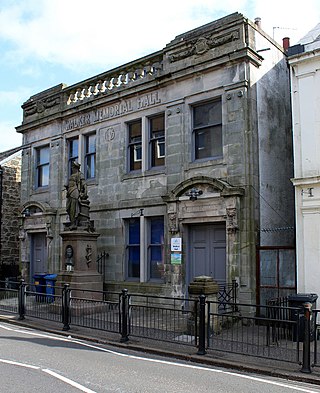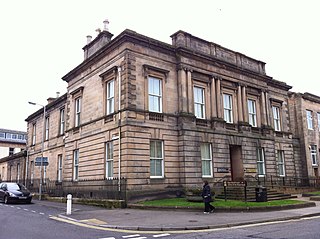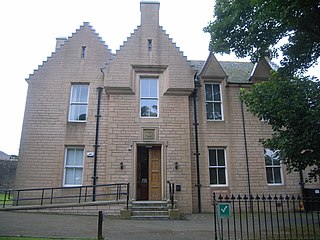
Kintore Town House is a municipal structure in The Square, Kintore, Aberdeenshire, Scotland. The structure, which is used as commercial offices, is a Category A listed building.

County Buildings is a municipal structure in the High Street in Kinross, Perth and Kinross, Scotland. The structure, which accommodates the local area offices for Perth and Kinross Council, is a Category B listed building.

Kinross Town Hall forms part of a complex of municipal buildings in the High Street, Kinross, Perth and Kinross, Scotland. The town hall, which has been converted for residential use, is a Category B listed building.

Denny Town House is a municipal building in Glasgow Road, Denny, Falkirk, Scotland. The structure is used by Falkirk Council for the provision of local services.

Falkland Town Hall is a municipal building in the High Street, Falkland, Fife, Scotland. The structure, which has been converted for use as offices and as shops, is a Category A listed building.

Newburgh Town House is a municipal building in the High Street in Newburgh, Fife, Scotland. The structure, which is used as a series of artists' studios, is a Category B listed building.

Wick Town Hall is a municipal building in Bridge Street, Wick, in the Highland area of Scotland. The structure, which is used as a community events venue, is a Category B listed building. It formerly served as the meeting place of both Wick Town Council and Caithness County Council.

Cromarty Courthouse, formerly Cromarty Town House, is a municipal building in Church Street, Cromarty, in the Highland area of Scotland. The structure, which is used as a museum, is a Category A listed building.

The Walker Memorial Hall is a municipal building in Main Street, Kilbirnie, North Ayrshire, Scotland. The structure is currently used as the offices for various local community groups as well as for the local Citizens Advice Bureau.

Coldstream Town Hall is a municipal building in the High Street, Coldstream, Scottish Borders, Scotland. The structure, which currently accommodates a library and a registration office, is a Category B listed building.

Elgin Sheriff Court is a courthouse in the High Street, Elgin, Moray, Scotland. The structure is a Category B listed building.

Kirkwall Sheriff Court is a judicial structure in Watergate, Kirkwall, Orkney, Scotland. The structure, which was the headquarters of Orkney County Council and is currently used as a courthouse, is a Category C listed building.

Paisley Sheriff Court is a municipal structure in St James Street, Paisley, Renfrewshire, Scotland. The complex, which was the headquarters of Renfrewshire County Council and is currently used as a courthouse, is a Category A listed building.

County Buildings is a municipal structure in the High Street, Dingwall, Highland, Scotland. The complex was the headquarters of Ross and Cromarty County Council and is currently used by The Highland Council as offices for the provision of local services.

The Highland Council Headquarters, formerly County Buildings, is a municipal structure in Glenurquhart Road, Inverness, Highland, Scotland. The oldest part of the complex, which currently serves as the headquarters of The Highland Council, is a Category C listed building.

Wick Sheriff Court is a judicial structure in Bridge Street, Wick, Caithness, Scotland. The structure, which remains in use as a courthouse, is a Category B listed building.
The Old Town Hall Chambers is a historic building in the High Street in Newport Pagnell, a town in Buckinghamshire, in England. The building, which served as a public events venue, is a grade II listed building.

County Offices is a former municipal building on Main Street in Golspie in Scotland. The building, which used to be the headquarters of Sutherland County Council, is now divided into seven residential properties known as 1-7 The Old Post Office.

Dornoch Sheriff Court, also known as County Buildings, is a former judicial building on Castle Street in Dornoch in Scotland. The building, which is now used as a restaurant, is a Category B listed building.

Stornoway Sheriff Court is a judicial building on Lewis Street in Stornoway in Scotland. The building, which continues to be used as a courthouse, is a Category B listed building.





















